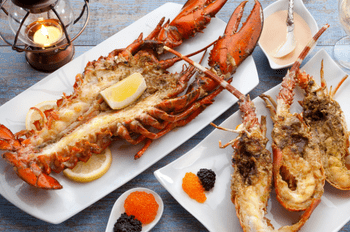Freezing Live Lobster is a Terrible Idea. Do this instead!
I’m going to assume you just bought live a lobster and you want to set it aside for a special meal. What do you do with food you want to preserve? Freeze it of course! Lobsters aren’t like most foods. You need to approach preserving lobster differently.
Freezing live lobster will kill it and allow for rapid bacterial growth upon thawing, which will ruin the quality of the meat. Instead, blanch live lobster with boiling salt water for 60 seconds followed by a 20 minute ice bath. Next, vacuum seal and freeze to preserve the lobster for 12 months.
Instead of freezing lobster, you may want to consider refrigerating it, since this won’t kill a lobster. This depends on how long you plan on preserving your lobster.
Live lobsters can be preserved in the refrigerator for up to 48 hours. Wrap the lobster in damp paper towels with a little wiggle room. Do not place the lobster in any air-tight container or bag to avoid suffocating it. The cool temperature will slow the lobster, keeping it stationary and alive.
Bottom line: Cooking a lobster assures the meat will be at a higher quality.
The underlying message here is to keep the lobster alive until you cook it. Blanching a lobster then freezing it will do the trick until you actually steam and serve it, but only because of the bacteria-killing exposure to boiling water during the process.
Lobsters are dirty bottom-feeders like crabs, and harbor lots of bacteria, which will ruin the meat if you don’t cook it fast enough. A study on Norwegian Lobsters found that the taste and smell of lobster tails was negatively affected with in increase in time between extracting and icing a lobster tail (Source). It found that the lobster tail’s meat was ruined after only four hours.
It’s common practice among studies to steam lobsters alive before testing meat quality, shelf life, etc. In a 2005 study, for example, lobsters were steamed alive before comparing the longevity and quality of each lobster group’s meat contents when put in different brines (Source).
By cooking a lobster, you kill off that bacteria. From there, you can clean the meat from the shell and store it for months. It will taste fresher, and can be used in a variety of recipes. Lobster mashed potatoes is one of my favorites.
Blanching lobsters is the only proven way to preserve lobsters in the freezer.
If you want to save cooking lobsters for a later date, the only way to do so is to blanch the lobster. This preserves the lobster in its shell by removing any bacteria due to heat exposure and salt coating. It’s a quick, 30-minute process that can be achieved in a few steps.
How to Preserve and Freeze Live Lobsters
- Boil a pot of water deep enough to fully submerge your lobster.
- Mix in salt to make the water approximately 2% sodium content. Use 1 cup of non-iodized salt for every 8 cups of water.
- Prepare a bowl of ice water near the pot of boiling water that can also fully submerge your lobster.
- While the water is boiling, carefully use tongs to submerge the lobster in the boiling water. Set a timer and do this for 60 seconds.
- After the lobster has sat in the boiling water for 60 seconds, remove it with the same pair of tongs and place it in the bowl of ice water. Be cautious of the lobster being hot. Set another timer for 15 minutes.
- After the lobster has sat in the ice water for 15 minutes, remove it and pat it dry with paper towels.
- Vacuum seal or use freezer bags for each lobster. Use 1 gallon-size bag for each lobster to avoid cross contamination. If you’re using freezer bags, press down to remove as much air from the bag as possible.
- Place each bagged-lobster in the freezer at 0 degrees Fahrenheit. They will stay fresh for up to 12 months.
- When you choose to cook this blanched lobster, take it out of the freeze and thaw overnight. If you do not thaw it, the meat will stick to the shell. Steam the lobster for at least 15 minutes and serve however you like.
For step seven, I use these zip lock bags on Amazon because they’re cheap (Affiliate link). You don’t have to spend hundreds of dollars on a vacuum sealer for this.
Works Cited
Albalat, A., Gornik, S.G., Mullen, W., Crozier, A., Atkinson, R.J.A., Coombs, G.H. and Neil, D.M. (2011), Quality changes in chilled Norway lobster (Nephrops norvegicus) tail meat and the effects of delayed icing. International Journal of Food Science & Technology, 46: 1413-1421. https://doi.org/10.1111/j.1365-2621.2011.02650.
Calder, B.L., Bushway, A.A., Bayer, R.C., Davis-Dentici, K.A. and Camire, M.E. (2005), Quality of Whole Lobster (Homarus americanus) Treated with Sodium Tripolyphosphate Before Cooking and Frozen Storage. Journal of Food Science, 70: C523-C528. https://doi.org/10.1111/j.1365-2621.2005.tb08299.


